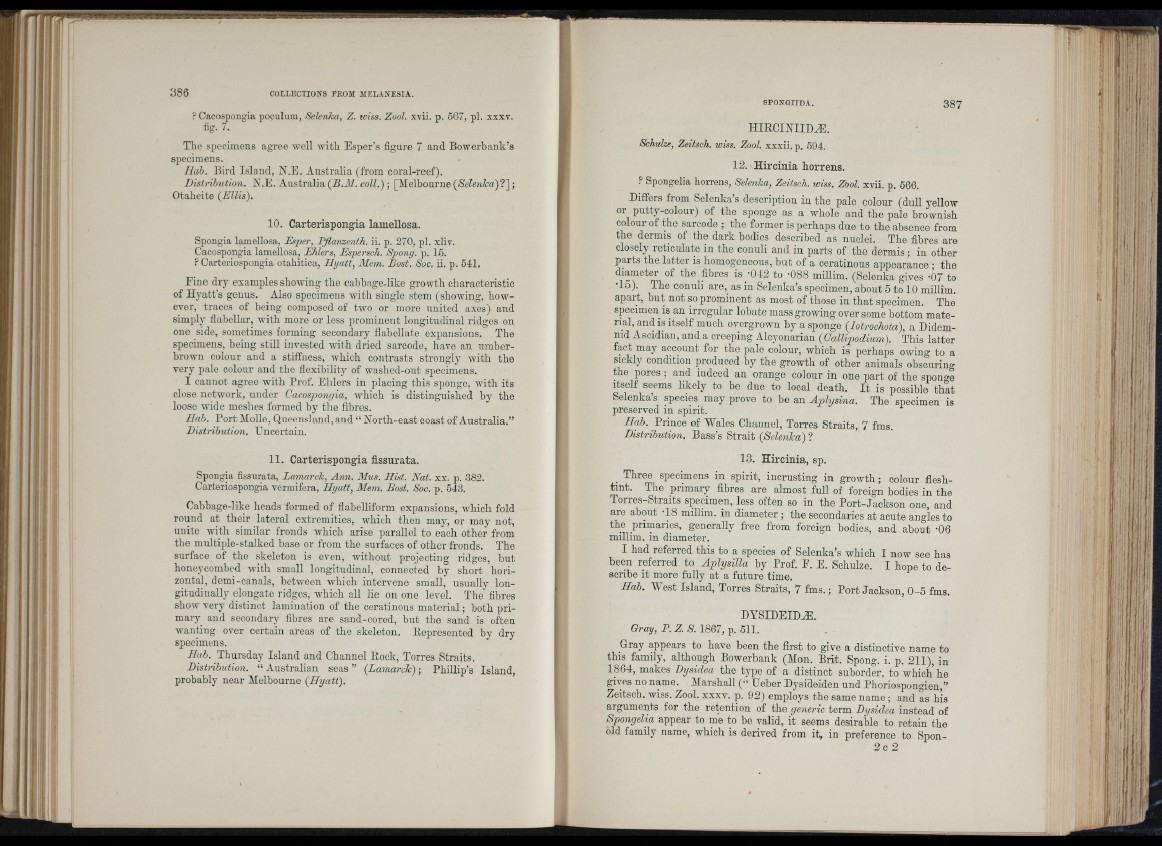
? Cacospongia poculum, Selenka, Z. wiss. Zool. xvii. p. 667, pi. xxxv.
lig. 7.
Tho specimens agree well with Esper’s figure 7 and Bowerhank’s
specimens.
Hah. Bird Island, N.E. Australia (from coral-reef).
Distribution. N.E. Australia (B.M. coll.) \ [Melbourne (Selenlca)"!) ;
Otaheite (Ellis).
10. Carterispongia lamellosa.
Spongia lamellosa, Esper, Pflanzenth. ii. p. 270, pi. xliv.
Cacospongia lamellosa, Ehlers, Espersch. Spong. p. 15.
P Carteriospongia otahitica, Hyatt, Mem. Bost. Soc. ii. p. 541.
Eine dry examples showing the cabbage-like growth characteristic
of Hyatt’s genus. Also specimens with single stem (showing, however,
traces of being composed of two or more united axes) and
simply fiahellar, with more or less prominent longitudinal ridges on
one side, sometimes forming secondary flahellate expansions. The
specimens, being still invested with dried sarcode, have an umber-
hrown colour and a stiffness, which contrasts strongly with the
very pale colour and the flexibility of washed-ont specimens.
I cannot agree with Prof. Ehlers in placing this sponge, with its
close network, under Cacospongia, which is distinguished by the
loose wide meshes formed by the fibres.
Hab. Port Molle, Queensland, and “ North-east coast of Australia.”
Distribution. Uncertain.
11. Carterispongia fissurata.
Spongia fissurata, Lamarck, Ann. Mus. Hist. Nat. xx. p . .382.
Carteriospongia vermifera, Hyatt, Mem. Bost. Soc. p. 543.
Cahbage-like heads formed of flahelliform expansions, which fold
round at their lateral extremities, which then may, or may not,
unite with similar fronds which arise parallel to each other from
the multiple-stalked base or from the surfaces of other fronds. The
surface of the skeleton is even, without projecting ridges, hut
honeycombed with small longitudinal, connected by short hoii-
zontal, demi-canals, between which intervene small, usually longitudinally
elongate ridges, which all lie on one level. The fibres
show very distinct lamination of the ceratinous material; both primary^
and secondary fibres are sand-cored, but the sand is often
wanting over certain areas of the skeleton. liepresented by dry
specimens.
Hab. Thursday Island and Channel Rock, Torres Straits.
Distnbution. “ Australian seas ” (Lamardc) ; Phillip’s Island,
probably near Melbourne (Hyatt).
HIR C IN IIDÆ .
Schulze, Zeitsch. wiss. Zool. xxxii. p. 594.
12. Hircinia horrens.
? Spongelia horrens, Selenka, Zeitsch. wiss. Zool. xvii. p. 566.
Differs from Selenka’s description in the pale colour (dull yellow
or putty-colour) of the sponge as a whole and the pale brownish
colour of the sarcode ; the former is perhaps due to tho absence from
the dermis of the dark bodies described as nuclei. The fibres are
closely reticulate in the connli and in parts of the dermis ; in other
parts the latter is homogeneous, but of a ceratinous appearance ; the
diameter of the fibres is -042 to -088 millim. (Selenka gives -07 to
•lo). The conuh are,_ as in Selenka’s specimen, about 5 to 10 millim.
apart, hut not so prominent as most of those in th at specimen. The
specimen is an irregular lobate mass growing over some bottom mate-
rial, and is itself much overgrown by a sponge (lotrochota), a Didem-
nid Ascidian, and a creeping Alcyonarian ( Callipodium). This latter
fact may account for the pale colour, which is perhaps owing to a
sickly condition produced by the growth of other animals obscuring
the pores ; and indeed an orange colour in one part of the sponge
Itself seems likely to be due to local death. I t is possible th at
feelenkas species may prove to he ao. Aplysina. The specimen is
preserved in spirit.
Hah. Prince of Wales Channel, Torres Straits, 7 fms.
Distribution. Bass’s Strait (Selenka) ?
13. Hircinia, sp.
_ Three specimens in spirit, incrusting in growth; colour flesh-
tint. The primary fibres are almost full of foreign bodies in the
Torres-Straits specimen, less often so in the Port-Jackson one, and
are about -18 millim. in diameter ; the secondaries at acute angles to
the primaries, generally free from foreign bodies, and about -06
millim. in diameter.
I had referred this to a species of Selenka’s which I now see has
been referred to Aplysilla by Prof. F. E. Schulze. I hope to describe
it more fully at a future time.
Hab. West Island, Torres Straits, 7 fms. ; Port Jackson, 0-5 fms.
DYSIDEIDÆ.
Gray, P. Z. S. 1867, p. 511.
Gray appears to have been the first to give a distinctive name to
this family, although Bowerhank (Mon. Brit. Spong. i. p. 211), in
1864, makes Dysidea the type of a distinct suborder, to which he
gives no name. Marshall (“ Ueher Dysideiden und Phoriospongien,”
Zeitsch. W IS S . Zool. xxxv. p. 92) employs the same name ; and as his
arguments for the retention of the generic term Dysidea instead of
Spongelia appear to me to be valid, it seems desirable to retain the
old family name, which is derived from it, in preference to Spon-
2c 2
i l l "
I ,1 " !
: ' iI '.I
'i r.
I
■ I
M l
j ,
■i